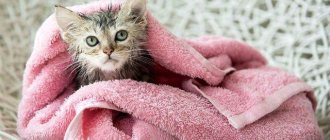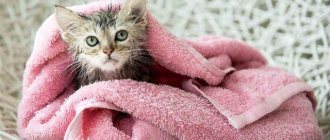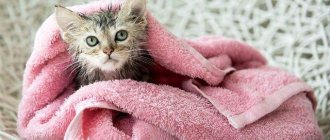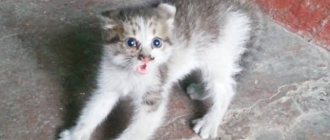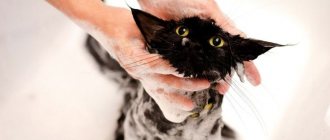Most cats avoid water treatments. However, this is one of the important components of hygiene. How correctly a kitten is bathed for the first time determines its attitude towards water for many years. Therefore, it is necessary to approach this event responsibly: choose a suitable detergent, study the advice of felinologists and, of course, be patient.
The advisability of bathing
Cats are very clean animals. They devote several hours every day to thorough licking. With the help of a rough tongue, pets are able to remove almost any dirt, as well as lost hair and skin flakes.
This desire for cleanliness has practical implications. Cats try to neutralize their own scent in order to sneak up on their prey unnoticed during the hunt.
Fear of water can also be explained. A wet pet quickly becomes hypothermic because it loses its ability to thermoregulate. Domestic cats living in “greenhouse” conditions have a rather weak immune system, which is not always able to withstand adverse factors.
If you bathe a kitten with an aggressive shampoo, the protective lubricant will disappear. Because of this, the fur becomes dry and brittle, and the skin begins to peel. Therefore, only special cosmetics are used for washing.
The kitten needs to be bathed when the following signs appear:
- the wool smells unpleasant;
- skin becomes sticky;
- abundant fatty deposits appear;
- the kitten has fleas;
- Dirt accumulates in the folds of the skin.
Cats are bathed if they are very dirty. For example, in any chemicals, soot, oil. In this case, licking the fur will cause serious harm to the health of the pet.
How to bathe at 2 months or more?
At the age of 2 months, it is better to wash the kitten without using shampoo using regular warm water. From 3-4 months you can start bathing with a special shampoo, which will determine the pet’s entire future attitude towards this procedure.
It is important to remember that kittens also have allergies and intolerances, so it is worth monitoring their condition after washing. If your pet shows signs of illness, you should immediately visit a veterinary clinic or listen to the doctor’s recommendations over the phone.
Contraindications to bath procedures
There are situations when it is absolutely forbidden to bathe kittens. These include:
- Illness - avoid water procedures until complete recovery.
- Vaccination – bathing kittens is prohibited for 14 days after vaccination.
- Ringworm - along with water, the infection will spread to other parts of the body.
- Surgery – After surgery, cats are not bathed until the stitches have healed.
- Severe stress - water procedures will only aggravate the condition.
Frequency of bathing
Veterinarians have developed a scheme that will help the owner decide when it is permissible to bathe the baby and how many times to carry out the event.
A one-month-old pet can be washed once, and a four-month-old pet can be washed twice a month. In addition to the age range, the frequency of the procedure depends on the time of year. In winter, the baby is washed no more than once, in spring and summer twice, in autumn - once, as in winter. Taking into account the needs of the cat, veterinarians advise carrying out the procedure in certain months - in January, March and mid-May, late June and August, as well as in October. Although the recommended scheme can vary and be adapted by the owner to suit his pet.
At what age can you bathe a kitten?
Kittens are more vulnerable than adult animals. Their immunity is still developing, so you shouldn’t risk bathing your pet too early. During washing, the temperature regime is disrupted and the fatty film that protects the baby from pathogenic bacteria is washed off.
There is no need to bathe kittens for the first 2 months after birth. The mother takes care of their hygiene. However, many breeders wash kittens as early as 1 month. This is due to the fact that they prepare animals for sale and try to provide the kids with the most attractive appearance.
In case of severe contamination, you can carefully wash a one-month-old kitten, but only if it is accustomed to its owners and has become comfortable in the apartment. If possible, it is better to limit wiping with a damp cloth.
At 3 months, when the kitten is stronger, you can start bathing it without harm to its health. There is no need to postpone the procedure. The sooner the baby gets acquainted with water, the sooner he will get used to it.
As for at what age you can bathe a kitten with flea shampoo, it largely depends on its brand. Typically, such drugs are not used for up to two months.
However, some mild flea shampoos can be used a little earlier. It is better to consult a veterinarian first and carefully study the instructions.
Optimal age for first bathing
Cats are excellent swimmers. Some varieties, such as the Turkish Van, love water and are willing to swim every day, this is due to the special structure of their coat. And the dislike of washing in most breeds is due to poor thermoregulation of these animals.
A wet cat, in addition to experiencing unpleasant sensations from the cold, is an easy prey for a hypothetical enemy, since it is helpless and its smell at this moment is too distinct. Therefore, the animal is in a hurry to shake the water off its fur and immediately dry itself with its rough tongue.
If the pet was purchased from a nursery, then there is no need to rush into the first bath. It is necessary to give the kitten time to get comfortable in the new home, because moving is a huge stress for the baby and it is not advisable to aggravate it.
But a kitten picked up on the street must not only be washed, but also treated for external parasites and dewormed if its health condition allows this.
Very small kittens, up to three months old, can simply be wiped with a wet sponge and combed.
Pedigree kittens, especially semi- or long-haired breeds, begin to be accustomed to water procedures from this age. This is especially true for Persian, Angora, and British cats.
If the animal is going to be exhibited, then it will have to be washed before each show, so it is important that this procedure becomes familiar and loved for the pet.
How often to wash
Cats' natural love for cleanliness makes bathing an auxiliary, rather than a primary hygiene procedure. On the contrary, too frequent washing degrades the quality of the fur.
The frequency of washing kittens depends on the breed, coat length, and health status. As a rule, cats are bathed 6 times a year. If the animal does not leave the apartment, bath days are held once a quarter or six months.
Often you can only wash kittens of hairless breeds. They get dirty faster, so they get water treatments about once a month. Show cats are given unscheduled baths before shows.
For your information. If a cat goes outside, be sure to wash its paws after each walk.
How to wash a kitten
Before bathing, play with your pet, talk to it gently, and do not do anything that might scare the animal. Follow a simple algorithm of actions:
- Before washing the cat, close the door;
- carefully place the animal in the bath;
- wet the wool;
- lather with shampoo, avoiding contact with the nose, eyes, ears;
- remove the soap mixture using a watering can or hand shower.
Wrap your pet in a large towel, let the cat come to its senses and calm down a little. If the kitten is not afraid of a hair dryer, dry the fur by setting the air flow to the optimal temperature. Use a special soft comb with wide teeth. Don’t forget to reward your kitten with his favorite treat; a tasty reward will help him cope with stress properly.
As an alternative to traditional water procedures, you can use special shampoo towels. Our online store offers products for express bathing without water:
How to wash a kitten
Kittens are bathed using gentle products. Shampoos are not suitable for people - they are too aggressive.
Manufacturers produce cosmetics for a specific skin type:
- dry;
- fat;
- normal;
- damaged.
The most common are liquid shampoos and conditioners. They can contain both regular cleaning agents and special components. For example, to kill fleas, ticks and other parasites.
There are other types of cat shampoos:
- Dry shampoo is in powder form. Contains absorbent components: they remove excess sebum and dead skin flakes. However, it is not able to cope with heavy pollution. Used as an express remedy for show pets or kittens that are afraid of water. Suitable for use in winter as it avoids hypothermia.
- Spray shampoo - works almost the same as dry shampoo. Moisturizes and conditions the coat, helps get rid of tangles. A good option for partial bathing, when you just need to refresh your coat.
Some owners use a mixture of baby powder, cornstarch or baking soda as dry shampoo. However, this is quite risky. By absorbing moisture, starch releases gluten. If water gets on the skin, it will swell and stick to the fur.
It will most likely not be possible to comb it out - the animal will still have to be washed. The soda must be carefully removed, otherwise the cat will be poisoned by eating it while licking it.
Important. It is better to bathe animals using industrial dry shampoos. For example, brands Trixie Trocken and Mr. Gee.
When choosing a detergent, you need to take the following points into account:
- Short-haired, long-haired and hairless kittens are bathed with shampoos from separate lines.
- You should buy shampoos designed specifically for cats, or at least for cats and dogs. However, some show cosmetics are only made for dogs. It is used in extreme cases.
- Concentrated shampoos are more expensive, but are more economical. Before use, they must be diluted with water according to the instructions.
The most popular cosmetics that can be used to bathe a kitten are presented in the table.
| Effect | Name |
| Against parasites | “Disinfectant” (Bioflor company); |
| "Lugovoy" (Agrovetzaschita); | |
| “Tar” (Clandestine); | |
| "Doctor ZOO" | |
| Medicinal | "Doctor" (Goodman); |
| "BioVax for kittens"; | |
| Beaphar Shampoo Anti Dandruff | |
| For damaged skin and coat | Iv San Bernard Zeolithe |
| Strengthening and restructuring the coat | YuuP! Professional Restructuring & Strengthening; |
| Tropiclean Lime/Coconut | |
| To regulate shedding and against tangles | FURminator spray; |
| Perfect Coat Shed Control & Hairball (8 in 1); | |
| Phytoelite (Veda) | |
| Caregiver | Iv San Bernard Atami (antistatic); |
| “Gentle”, “Marine” (Agrovetzaschita); | |
| “Velvet” (CrystalLine); | |
| Artero 4Cats | |
| To add volume | Anju Beaute Texture Volume |
Important. The kitten may be hypersensitive to some component of the detergent. Therefore, after bathing you need to monitor the baby’s condition. If an allergy occurs, you should contact your veterinarian.
What product should I use to bathe my kitten?
The skin of a person and a cat, no matter whether it is an adult animal or a small kitten, has a completely different reaction. So any detergents intended for humans, even the mildest and most neutral baby shampoos, are completely unsuitable for a kitten.
Is it possible to wash a kitten with soap? If a one-time emergency bath is still necessary, but there is no special “cat” shampoo on hand, you will still have to use baby soap or shampoo. Then choose not only the softest one, but also the one with the least odor. A scent that is pleasant to humans can be a real nightmare for a kitten and its relatives, since cats are very sensitive to odors. And you shouldn’t turn this into a regular practice - if possible, be sure to buy veterinary shampoo - let it be “just in case”, even if you are not going to repeat bathing in the near future.
It is best to wash a kitten found on the street with a shampoo that contains flea and tick additives. Such products are also necessary for those kittens who walk outside regularly.
For long-haired kittens, whose fur is especially difficult to wash, you can buy a special shampoo that makes combing easier. Such shampoos not only contain additives that detangle the fur, but are also easier to rinse off, otherwise you risk not completely rinsing the thick “fur coat” and getting exactly the opposite of the expected result. Unwashed wool will stick together, quickly absorb dust and look unkempt.
If the kitten has sensitive skin and after bathing it itches, dandruff, and irritation appear, you will have to change the shampoo. Sometimes you have to carry out more than one painful experiment for both the owner and the pet until you can choose the right bathing product for this particular baby.
How to properly bathe a kitten for the first time
If you bathe a small kitten correctly for the first time, he will not develop negative associations with this procedure. Therefore, it is so important that washing is as comfortable as possible.
Felinologists recommend adhering to the following rules:
- Do not bathe your cat after eating. Only a light snack is acceptable, but it is better to wash your pet on an empty stomach.
- It is advisable that the kitten bathe during the molting period. Washing will make the process easier, and the animal will not accumulate a lot of hair in its stomach.
- Before bathing your pet, carefully comb the fur coat and untangle the tangles. To prevent the kitten from scratching, it is advisable to shorten the claws.
- The bathroom should be protected from drafts.
- To wash your kitten for the first time, it is better to use unscented shampoo.
- At first, it is better to bathe the kitten with an assistant. One person will hold the baby, the other will perform the necessary manipulations.
- The water should not be too cold or hot. Optimum temperature +38…+40°C.
- The ears are plugged with cotton to prevent water from getting into them. If this happens, inflammation may develop.
- It is better to wet your head not with a stream of water, but with a damp sponge.
It is recommended to wash the kitten for the first time not in the bath itself, but in a small basin. This will make it easier to hold him, and the pet will feel more confident. To prevent the paws from slipping, place a rubber mat on the bottom of the container.
For your information. It is not advisable to bathe a kitten in a sink. He can escape, fall from a great height and get injured.
All necessary equipment - detergent, towels, treats, etc. - should be at hand. If your pet scratches a lot, you should take care of rubber gloves. They will protect your hands from sharp claws.
When all preparations are completed, the kitten is gradually immersed in water approximately up to the shoulders. You can allow him to hold on to the edge of the basin and at the same time pour water on him. To bathe your pet without scaring it, talk to the baby in a gentle voice during the process. A friendly intonation makes it clear that there is no threat.
Shampoo is diluted in a separate container in the required concentration and applied to the kitten’s body. The soap solution is carefully distributed with massaging movements, being careful not to wet your head. Particular attention is paid to:
- armpits;
- stomach;
- areas around the genitals;
- paws;
- places behind the ears.
More dirt accumulates here. If your pet is bathed with an antiparasitic agent, the neck is treated first to prevent fleas from escaping to the head.
Leave the shampoo on the fur for the time specified in the instructions, and then rinse the kitten with plenty of water. It is better to water the baby from a mug or wet the fur with the palm of your hand than to use a tap or shower - a powerful stream will scare the pet.
At the end, the fluffy is generously praised and treated to his favorite treat to reinforce positive associations.
How to wash a kitten for the first time
So, everything is ready. The pet was caught and placed in the bathroom. The harness is on, the ears are protected, the water is filled. It's time to start the procedures:
- It is better to grab the kitten by the scruff of the neck. So he will shrink into a ball and stop moving. This is a natural reflex.
- The water in the basin should be up to your belly. The kitten is gradually lowered into it so that its paws do not get wet quickly.
- The owner needs to talk to the baby all the time, using a gentle voice with soothing intonations.
- Handfuls of water are used to moisten the kitten's fur. You can use a shower, but then it must be turned on and adjusted in advance, and the pressure must be weak. But for the first time it is better not to use the shower.
- Lather the shampoo and rub into the fur. You don’t need to take a lot of product; a lot of foam will complicate the rinsing procedure. Then you need to wipe off the excess foam and start rinsing.
- You can rinse with a shower at low pressure. It is necessary to rinse off the shampoo thoroughly, otherwise the remaining product will dry out the skin and fur of the animal, which will cause itching and irritation.
- After rinsing, the kitten should be wrapped in a towel. Blot the moisture with it, remove it, and then wrap it in a prepared dry towel.
- Take the kitten to the heater or to its house. The baby will dry itself, the main thing is that there are no drafts.
Video: how to bathe a kitten for the first time
How to wash individual parts of a kitten's body
Kittens do not need to be washed entirely. Sometimes certain parts of the body require more careful care. The paws can be washed under running water under the tap. The face and ears should be wiped with a damp, clean cloth.
How to wash representatives of different breeds
Representatives of different breeds require a special approach to bathing:
- Shorthaired Scots and Britons who devote a lot of time to grooming can be bathed once every six months.
- Long-haired cats, such as Persian or Siberian cats, need to be washed every 2 months.
- White kittens are bathed with whitening shampoos.
- Detergents for long-haired breeds are not used for short-haired kittens with abundant undercoat.
- It is not advisable to bathe kittens of white and blue colors, particolors and silver pets with herbal shampoos.
- To wash Sphynxes and other hairless cats, specialized shampoos are used that care for the skin. The head is wiped with sanitary napkins.
- Products for adding volume are not suitable for animals with tight-fitting hair without undercoat (Siamese, Oriental, Abyssinian cats, etc.).
Should I bathe a kitten after vaccination and castration?
After vaccination, the kitten cannot be bathed for at least 2 weeks, because during this period the animal’s immunity will be reduced by the vaccine. You should also not bathe before vaccination, so as not to reduce your immunity with stress.
After castration and sterilization, at least 10 days must pass before swimming, because... During this period, the sutures heal.
It’s also not worth bathing a kitten in the first days after you take it home. The animal is experiencing terrible stress, which you will only intensify, as a result of which its immunity will drop. The exception is yard cats, which, of course, need to be washed immediately.
Rate and share!
How to teach a kitten to bathe
Bathing is a serious stress for your pet. To avoid health problems and not to injure the baby’s psyche, he needs to be prepared before the first wash.
Important. Kittens subtly sense people's moods. If the owner is nervous, the anxiety will be transmitted to the pet. Therefore, before swimming you need to calm down and relax.
First, the kitten is placed in a dry bath and they try to play with it. He needs to understand that it is safe here. When the baby gets comfortable, open the tap. Some pets themselves show interest and begin to play around with a thin stream of water.
The process is repeated several times until the kitten becomes absolutely calm about the procedure. Cats that cannot get used to water can be bathed in mesh bags. They restrict the movement of animals, but do not prevent water and detergents from entering the body.
Preparing for a swim
So, the bath day is set. It’s worth remembering the baby’s first bath: the difference is small. You need to prepare everything in advance:
- It is better to warm up the room if there is a heater;
- eliminate drafts;
- draw warm water for bathing and rinsing, the temperature should be between 37–40 ° C;
- prepare a towel (preferably two: the first will absorb moisture, the second can dry the wool).
It's better to use some kind of container. The noise of a “waterfall” from a faucet or “heavenly abyss” from a shower can throw your pet into panic, and you will have to forget about a calm bath.
Inventory
It is not advisable to bathe a kitten in the bath itself . Firstly, a huge space filled with water will terrify the baby. Secondly, in order for the baby to be calmer, he needs to cling to something. The edge of the basin will fit perfectly. It is not advisable to use a sink for bathing: it is traumatic (the kitten can escape and fall from a great height) and inconvenient (splashes and puddles underfoot, of which there will be a lot, can play a cruel joke on the owner himself).
To make it easier to hold a struggling pet, you can use a leash-harness. It will reliably prevent the baby from escaping. And for the especially obstinate, you can purchase a special bag for swimming. It is made of synthetic materials and has a large mesh structure. Equipped with a special cord for secure fixation around the neck. The use of such a bag will ensure swimming without bloody battles.
Water and detergent penetrate perfectly through the large cells of the bag, but the pet is unlikely to scratch the owner
This bag can also be used for other procedures such as ear cleaning.
You don't need a washcloth to bathe a kitten. It is enough to carry out the procedure by hand. Soft gentle movements will calm the baby.
It is strictly forbidden to wash your cat's hair while bathing. Water can get into your ears, causing serious health problems. To protect them, you can use cotton swabs or purchase a special swimming cap.
A swim cap (a copy of the one people use, only smaller) will prevent water from accidentally getting into your ears
Detergents
For bathing, you need to use special products for kittens. You should not use shampoo for adult animals: the fatty lubricant in kittens is not yet sufficiently formed, and the acid-base balance of the baby’s skin can be disrupted. Moreover, you can’t use shampoos for people, including children’s. The pH of our skin is different from that of cats, and such products can greatly dry out the epidermis of pets.
There are special shampoos designed for certain breeds, for example, for sphinxes or owners of luxurious long-haired fur coats. This also needs to be taken into account.
There are special shampoos for some cat breeds, such as Sphynx cats.
Types of special means for washing kittens
Apart from traditional liquid shampoos, alternative bathing products such as sprays and dry shampoos are widely available in the market. This is a real lifesaver for those pets who are already very scared of water. Also, these products can save you from unnecessary hassle if your pet is slightly dirty or there are no conditions for swimming (on a train, for example).
Dry shampoo is applied to dry fur, distributed over it and combed out. The spray should be applied to damp wool, gently rubbed into the coat and the residue removed by combing. These products are also good because they are suitable for frequent use and do not affect the fatty layer of the skin. The only problem that the spray can cause is getting into the eyes and respiratory tract, so it must be used without fanaticism.
Table: rating of popular and high-quality special products for bathing kittens (according to Yandex.Market)
| Name | Manufacturer | Description | Price, rubles |
| Ms.Kiss “Fluffy Ponytail” | Russia |
| 150–200 |
| Shampoo for kittens 8in1 Tearless Kitten Shampoo | 8in1, Russia |
| 500 |
| Le Artis Herba Vitae shampoo with chamomile and coltsfoot extracts for kittens | Russia |
| 100 |
| Shampoo for kittens “Gentle” | Agrovetzaschita, Russia |
| 100 |
| Dry shampoo Ms.Kiss | Russia | Does not require rinsing | 450–500 |
Photo gallery: popular shampoos for kittens
Biotin included in the “Fluffy Tail” soothes irritated skin, helps get rid of flaking, strengthens hair from root to tip. Tearless Kitten Shampoo without tears contains an ultra-soft formula for delicate cleansing and protection of the kitten’s delicate and sensitive skin. Dry shampoo does not require rinsing and helps to quickly restore tidy up your pet's fur
Herba Vitae is a Russian line of shampoos for dogs and cats, developed based on natural ingredients
How to dry
After bathing, the pet is dried with a terry towel and wrapped in a soft cloth. You should not rub the fur vigorously - it will become very tangled.
Then the kitten is released. He begins to actively lick himself and dries his coat on his own. The rough tongue combs the hairs and evenly distributes protective lubricant over them.
If your baby trembles for more than 5 minutes after bathing, you should use a hairdryer. The same applies to long-haired breeds. However, the baby must first be introduced to this device, otherwise he will be scared. The air flow should be warm, but not hot. During the drying process, the fur is combed in the direction of hair growth.
Important. For 12 hours, the kitten should be in a warm room without drafts and not go outside.
If you bathe a kitten correctly, it will not be afraid of water. It is important to teach your baby hygiene from childhood and use suitable detergents - then the procedure will not cause much trouble.
Bathing algorithm
You can buy your baby in a sink or basin. He must stand confidently on his feet. To prevent the slippery surface from scaring the baby, it is better to use a rubber mat or towel. The water should reach the neck, covering the body, and have a comfortable temperature between 36–39 degrees. For the procedure, use a soft washcloth.
The animal is carefully grabbed by the scruff of the neck so that it cannot escape, run away or scratch the owner. It is first necessary to wet the fur, plug the ears with tampons, and put special drops into the eyes, since getting liquid into them is fraught with the development of inflammatory processes. It is more convenient to wash your four-legged friend in the shower, holding him with your left hand and showering with your right hand. The product is applied to the pet's paws, stomach, back and tail. The head should be left for last; washing it is the most unpleasant for any cat. The easiest way to wash off foam is from top to bottom.
At the end of all manipulations, the clean pet is wrapped in a warm towel. It is recommended to prepare two towels, one of which should be thick. The procedure cannot be carried out earlier than 4 hours after eating.
Cleanliness is in the blood
Looking at how thoroughly a cat licks itself several times a day, how quickly and efficiently its rough tongue sweeps away all obstacles in the form of dirt, dust and specks entangled in its fur, some owners cannot even think that cats need to be washed additionally. But do not shift all hygiene responsibilities to your pet, since he still needs bathing.
- Look at the cat. It does an excellent job of keeping the coat clean. Now look out the window. Most likely, you will see a lot of cars, people, other animals, as well as mountains of garbage and dirt. All this settles on your pet’s fur, accumulates on it day after day, and then goes straight into the stomach. Even domestic cats need to be cleaned, since the owners bring litter and dust into the house on their shoes.
- Seasonal shedding is an inevitable period in a pet’s life. He washes himself with the same thoroughness, but where does most of the hair that has already fallen out end up? That's right, into the cat's stomach. Lucky cats simply present surprises to their owners in the form of regurgitation of fur onto their favorite carpet, while less fortunate cats may experience intestinal obstruction.
- There can be no question of neglecting to bathe a cat that is infected with fleas or is soiled with something that can get into the stomach and harm it.
These reasons deserve attention, but you shouldn’t drop everything and drag your pet into the bath for treatments. We come to the main question: how many times to bathe a cat.
Newborn kittens: arguments against early bathing
Newly born babies are still helpless, so their mother takes care of them. The cat constantly licks the kittens, so in the first months of life there is no need for washing.
But the main argument against early washing is a poorly developed nervous system. The aversion to water in cats is genetic. Therefore, contact with her makes the baby instinctively tense. This provokes stress, which not every kitten can cope with.
The second “cons” is weak immunity. The baby may freeze both during and after washing.
Wet fur does not protect against the cold, and the thermoregulation mechanism has not yet formed. Therefore, bathing often ends with the kitten catching a cold.
Washing a newborn is only allowed as a last resort - when the mother's licking does not save from parasites, and fleas simply eat the baby.
How to bathe a cat at home?
Bathing a cat can be comfortable if you follow some rules. First, find yourself a partner. A cat is a small creature, but bathing it with four hands is more convenient. One holds the animal, and the second carries out manipulations.
Next, step-by-step instructions on how to properly bathe a cat at home .
Before you bring your pet into the bathroom, prepare everything you need.
List of what you will need:
- medium-sized shallow basin;
- a saucepan with warm water;
- ladle;
- cotton wool;
- sponge;
- brush;
- detergents;
- a set of terry towels;
- hair dryer;
- delicacy;
- rubber gloves (we reserve this item for those animals that fundamentally do not submit to the “humiliating” need to be clean by force and tear their owners’ hands to shreds with their claws);
- nail clipper
Step 1: Prudent.
Combine business with pleasure and trim your pet's nails. You remember that this needs to be done from time to time? This procedure before bathing is also intended to once again protect you from the wrath of your pet. However, there are radical methods for permanently declawing a cat, but we are not talking about extreme measures now.
Step 2. Preliminary.
Pour water into a bowl and into a saucepan. At what temperature should you bathe a cat? Considering that a cat’s body temperature is higher than that of a person, a water temperature of 30-38 degrees will be comfortable for it. But bathing in a large bathtub cannot be called comfortable for a cat, since huge expanses of water will plunge the cat into panic. A bowl of warm water is sufficient for cat procedures. Bring towels into the bathroom in advance and open bottles of detergent.
Step 3: Discreet.
Plug the animal's ears with cotton swabs to prevent water from entering. And only after that bring the cat into the bathroom.
Step 4. Extreme (as well as all subsequent steps).
How to bathe a kitten if it panics? In cold blood! Talk to him in a calm voice, showing that you are the boss of this flock and know what you are doing.
Don’t put the baby in a bowl of water right away, just wet the woolen coat as much as possible with a sponge soaked in water, trying not to scare the cat with random noise. This is why we recommended pouring water in advance.
Then you should take the detergent and rub it into the fur slowly, carefully, with massaging movements. Is it worth reminding us that we try not to get the cat’s head wet at all?
Step 5.
Use a brush to very carefully remove the resulting foam and then place the cat in the basin, pouring water from the ladle over it. If there is not enough water, then you will need an additional portion, poured into the saucepan in advance. The cat will be calmer in the basin if there is something there that he can grab onto with his claws. Some owners put the animal directly into a bowl of water, some put it in an empty basin - you can only choose your option experimentally.
The eyes and ears (outside) can be wiped with a damp hand.
Step 6.
Finally, we wrap the cat in a towel and try to hold it so that the wet animal in the wild does not become hypothermic. Rubbing with a towel is harmful to the coat, so we only blot the moisture, changing towels as needed.
Step 7
The next step is blow drying. We hold the scary and buzzing device at a distance of 30 cm from the animal’s body. Some experts convince that only long-haired cats should be blow-dried, but it seems to us that to prevent colds, it is better not to pay attention to the length of the coat, because the cat itself takes a long time to dry. If you leave a cat in a warm room after bathing, it will dry completely only after 12 hours!
Step 8
We comb out the fur with special combs and brushes, thus finally removing dead hair.
Step 9
We motivate the dried and combed cat with a treat, so that next time bathing will be associated only with pleasant moments.
This is interesting: How to rid a cat of fleas?
Stage No. 2. How to properly wash a cat
When everything is ready, let's start swimming. Many owners are worried when they have to bathe their cat for the first time. This is natural, but to prevent your anxiety from being transmitted to the animal, try to calm down; all your actions should be confident and clear.
How to keep a pet
So, we take the cat in our arms so that you hold the crossed front legs with one hand and the hind legs with the other.
Carefully but confidently we begin to lower the animal into the prepared water. They usually react calmly, even if this happens for the first time
When the animal rests its paws on the bottom of the sink or bucket, the hind paws can be released.
The front ones must be fixed with the left hand at all times. Therefore, you will have to work only with your right hand. If you wash the cat together, then your assistant should hold it.
Washing technique
But now the animal is in the water, what next? A video on how to properly wash a cat (the principle is the same, if you do not take into account the weight of the animals), of course, will help you understand the basic subtleties of this “operation,” but you will need to “feel” some things yourself, in practice. Imagine that you are washing an expensive wool sweater. Your movements should be calm and gentle.
Sort the wool under water until the solution saturates it completely. There is no need to rub the fur with your hand or sponge - this is a mistake. Make sure that water does not splash on the cat's face - in the eyes and nose, and also does not get into the ears while you are washing its body.
Wash your head and face last, with extreme caution.
Make sure your shampoo is “tear-free.” If the hair around the eyes and ears is very dirty, you should use pre-prepared lotions. Apply them to cotton pads and rub your eyes and ears until they are clean.
Changing water
When you see that the water has become dirty, let it drain completely from the sink, close the cap and start pouring the shampoo solution from the jug onto the animal. Once you have used almost all of the solution and the wool is well saturated with the product, run the water and fill the sink with water.
If you feel that the resulting solution is not concentrated enough, add a little more shampoo, but this is usually not required. After rinsing the fur a second time (if you need to give the cat a proper bath), drain the water and begin the rinsing procedure.
Rinsing cat fur
It is carried out in the same way as washing. Dissolve the conditioner in plenty of water. Change the water in the sink as often as possible and rinse the coat until all the shampoo has been removed and the coat is completely clean. Make sure you rinse off the shampoo and conditioner completely, especially in the groin, stomach, and neck.
Washing a cat is a big deal, but it is important to complete the procedure to the very end, no matter how much you want to finish it as soon as possible. Be careful: shampoo residue on your pet's skin can cause irritation and itching.
Is it possible to wash a kitten with laundry soap?
The most natural soap is considered to be laundry soap. It is valued for its good cleaning ability. But it is wrong to believe that it is suitable for bathing kittens.
Common people believe that they can wash cats with laundry soap. It’s better not to do this, but to choose a less aggressive one, with a low alkali content or a neutral PH level.
If there is no special shampoo and the kitten needs to be washed, a solution of laundry soap will do. It is suitable as an emergency measure. The cat may develop dandruff and itchy skin after a bath. Some cats experience hair loss, and allergic reactions are possible.
Laundry soap 72% from the era of socialism for a pet is a kind of poison. It is important to rinse the wool well so that the pet is not poisoned by soap components.
If you find problems after washing with laundry soap, you should immediately contact a veterinarian. He will tell you how to minimize the effects of alkaline attack on the skin.
The importance of choosing the right detergent for your furry pet
If the shampoo is chosen incorrectly, it will negatively affect the condition of the cat's coat.
The hair will become brittle, dull, begin to get tangled, and form clumps. The skin condition may worsen. When using inappropriate products, the dermis becomes dry and there is a risk of dandruff.
It is important to take a responsible approach to choosing shampoo.
Your pet needs to be given proper care to avoid problems with its fur and skin . Responsibility for the health of the animal lies with the person.
What happens if the animal is regularly washed with a non-special product?
The systematic use of shampoos that are unsuitable for cats leads to changes in the structure of the hairs, the activity of the fatty glands is disrupted, and the condition of the skin deteriorates .
The development of allergies cannot be ruled out. Because of this, the immune system weakens. The pet becomes more susceptible to various diseases.
Acceptable Bathing Frequency
In kittens up to 1 month old, the mechanism that regulates heat exchange has not yet fully formed, so a wet baby will freeze. In addition, the detergent used during the procedure breaks down fats and washes them off the surface, leaving the pet’s skin completely defenseless.
When the fur is licked by the mother, and then by the grown cat himself, such problems do not arise. Cat saliva does not remove the lipid layer from the skin and moderately wets the hairs. Physiological processes are not disrupted, and the kitten becomes clean.
Therefore, it is enough to wash the baby during the teething phase, and then repeat the procedure after six months or 10-12 months. More frequent bathing is not advisable.
Ringworm and bathing: possible or not
The dermatological problem is localized in one place. As soon as you dip a kitten with lichen in water, the spores will begin to spread throughout the body, so you should not bathe a pet suffering from this disease.
The hygienic procedure is allowed only when the lichen has become a generalized form and the risk of developing a lesion has disappeared.
Shampoos for lichen, like folk remedies, are ineffective. If there is an urgent need to bathe a kitten with such a disease, it is recommended to choose detergents such as Itraconazole, Nizoral, Sebazole.
